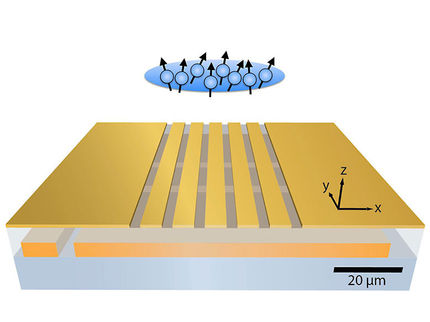Milestone on a nanometre level
Physicists succeed in characterizing the quantum state of a complex system Physicists from Marburg and the US have succeeded in characterizing the quantum state of a system consisting of millions of particles by bringing experimental data and theoretical predictions into agreement. The team of researchers headed by Professors Dr. Stephan Koch und Dr. Mackillo Kira from Philipps-Universität published their results in the renowned journal “Physical Review Letters”.
Modern semiconductor devices, chemical reactions and even biological behaviour are based on nanoscale processes with one nanometre being equal to one millionth of a millimetre. Processes on this scale operate according to the intricate principles of quantum mechanics which are in general highly complex and often unintuitive. In order to design and control such nanosystems, one has to understand the entire underlying quantum mechanic state.
“This objective is currently unreachable for any system larger than a few atoms or ions for the simple reason that the direct measurement of the quantum state would immediately exhaust all resources known to mankind concerning data acquisition, storing, and processing.” explained co-author Koch.
The scientists elegantly avoided this problem by optically exciting the electrons of thin semiconductor quantum wells. Instead of probing the quantum state directly, they carried out high precision measurements to detect subtle changes in the optical quantum-well absorption. Applying cutting-edge many-body theory, they performed rigorous comparisons of the experimental data and the theoretical predictions. „Our detailed comparison between quantitative experiment and theory showed that the absorption behaviour strongly depends on the many-body configuration.” remarked Kira. Thus, it was possible to identify the quantum states of the optically active electrons with a so far unprecedented accuracy.
“This result represents a first milestone towards the characterization of nanoscale processes in semiconductors,” commented Koch, and Kira added that one of the next steps would be to try to control the quantum state of large systems. This could potentially be performed in semiconductors by a detailed control of the quantum aspects of the optical excitation. This project will again be undertaken in cooperation with experimental physicists from the National Institute of Standards and Technology and the University of Colorado in den USA.
Original publication: R. P. Smith & al; "Extraction of Many-Body Configurations from Nonlinear Absorption in Semiconductor Quantum Wells”; Physical Review Letters 104 (2010), 247401
Other news from the department science

Get the chemical industry in your inbox
By submitting this form you agree that LUMITOS AG will send you the newsletter(s) selected above by email. Your data will not be passed on to third parties. Your data will be stored and processed in accordance with our data protection regulations. LUMITOS may contact you by email for the purpose of advertising or market and opinion surveys. You can revoke your consent at any time without giving reasons to LUMITOS AG, Ernst-Augustin-Str. 2, 12489 Berlin, Germany or by e-mail at revoke@lumitos.com with effect for the future. In addition, each email contains a link to unsubscribe from the corresponding newsletter.





























































